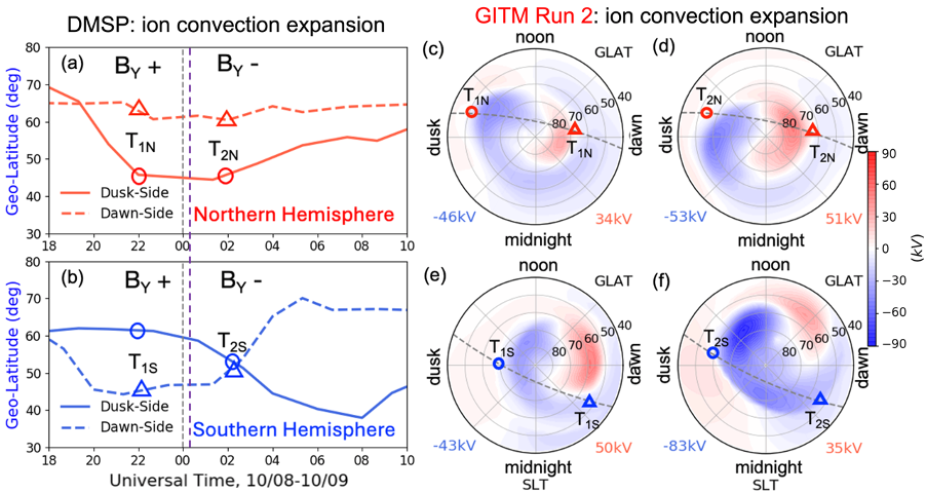Frontiers in Astronomy and Space Sciences—Yu Hong, Yue Deng, Qingyu Zhu, Astrid Maute, Marc Hairston, Cheng Sheng, Daniel Welling, and Ramon Lopez

(Left) Temporal variations of the ion convection boundary detected by the DMSP F16 on the dusk side (solid lines) and dawn side (dashed lines) in the (top) northern and (bottom) southern hemispheres. The vertical purple dashed line denotes the time when the IMF By reversed from positive to negative (around 00:20 UT October 9, 2012). (Right) Snapshots of the electric potential patterns in the northern (top) and southern (bottom) hemispheres at 22 UT on October 8 (By positive) and 02 UT on October 9 (By negative). The circle and triangle symbols refer to the ion convection boundary on the dusk-side and dawn-side, respectively. The gray dashed line in each snapshot indicates the DMSP F16 trajectory.
The inter-hemispheric asymmetry (IHA) in the Earth’s ionosphere-thermosphere (IT) system can be pronounced during geomagnetic storms and its cause remains unclear. The IHA in the high-latitude electrodynamic forcings (e.g., ion convection and auroral particle precipitation) can contribute to the observed IHA in the IT system but a comprehensive understanding of the pathway is lacking. Numerical simulations could help address this question but accurate specifications of high-latitude forcings are needed. In this study, we utilize field-aligned currents (FACs) obtained from the Active Magnetosphere and Planetary Electrodynamics Response Experiment data set to specify the high-latitude electric potential in the Global Ionosphere and Thermosphere Model (GITM) to examine the IHAs in the IT system during the 8-9 October 2012 storm. It is found that the FAC-driven GITM simulation overperforms the simulation driven by empirical models in terms of capturing the spatiotemporal variations of the high-latitude ion convection. Meanwhile, it is found that the cross-polar-cap potential, hemispheric power and the convection equatorial boundary display significant IHAs. Furthermore, the thermospheric response during this storm are studied. It is found that the FAC-driven GITM simulation can well capture the neutral density response observed by the Gravity field and steady-state Ocean Circulation Explorer (GOCE) satellite on the dusk-side. In addition, the IHA in the neutral density response follows the IHA in the Joule heating dissipation with a time delay of ~3 h. Our study helps to improve the understanding of storm-time IHA in the high-latitude forcings and its effects on the IT system.